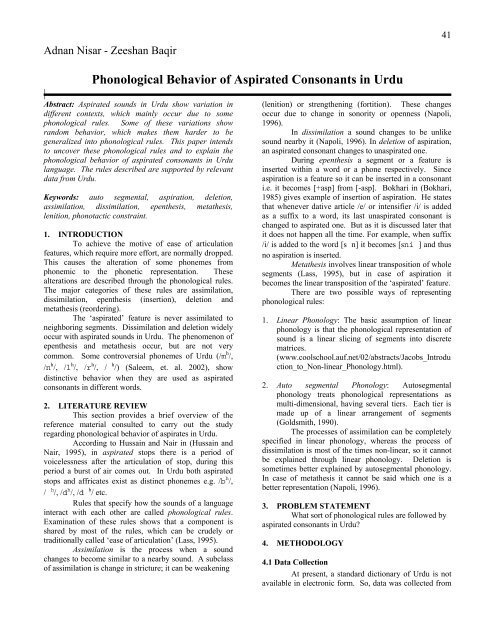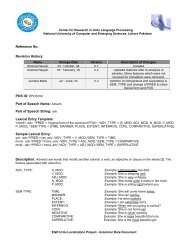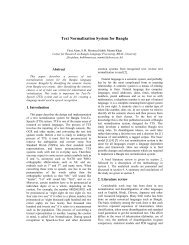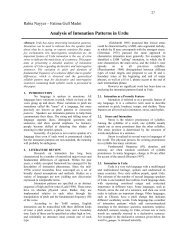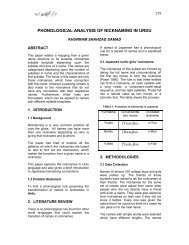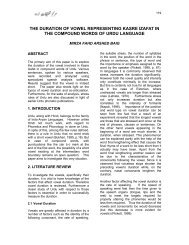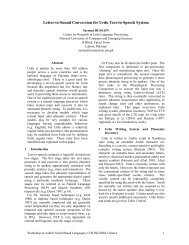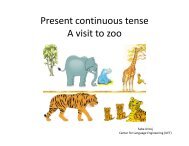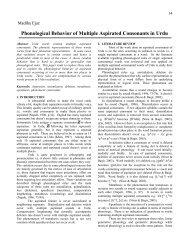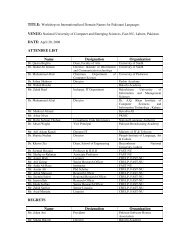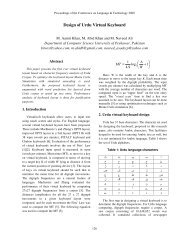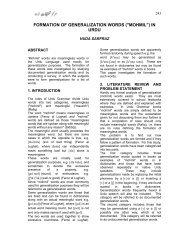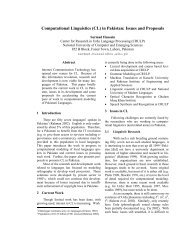Phonological Behavior of Aspirated Consonants in Urdu
Phonological Behavior of Aspirated Consonants in Urdu
Phonological Behavior of Aspirated Consonants in Urdu
You also want an ePaper? Increase the reach of your titles
YUMPU automatically turns print PDFs into web optimized ePapers that Google loves.
Adnan Nisar - Zeeshan Baqir41<strong>Phonological</strong> <strong>Behavior</strong> <strong>of</strong> <strong>Aspirated</strong> <strong>Consonants</strong> <strong>in</strong> <strong>Urdu</strong>|Abstract: <strong>Aspirated</strong> sounds <strong>in</strong> <strong>Urdu</strong> show variation <strong>in</strong>different contexts, which ma<strong>in</strong>ly occur due to somephonological rules. Some <strong>of</strong> these variations showrandom behavior, which makes them harder to begeneralized <strong>in</strong>to phonological rules. This paper <strong>in</strong>tendsto uncover these phonological rules and to expla<strong>in</strong> thephonological behavior <strong>of</strong> aspirated consonants <strong>in</strong> <strong>Urdu</strong>language. The rules described are supported by relevantdata from <strong>Urdu</strong>.Keywords: auto segmental, aspiration, deletion,assimilation, dissimilation, epenthesis, metathesis,lenition, phonotactic constra<strong>in</strong>t.1. INTRODUCTIONTo achieve the motive <strong>of</strong> ease <strong>of</strong> articulationfeatures, which require more effort, are normally dropped.This causes the alteration <strong>of</strong> some phonemes fromphonemic to the phonetic representation. Thesealterations are described through the phonological rules.The major categories <strong>of</strong> these rules are assimilation,dissimilation, epenthesis (<strong>in</strong>sertion), deletion andmetathesis (reorder<strong>in</strong>g).The ‘aspirated’ feature is never assimilated toneighbor<strong>in</strong>g segments. Dissimilation and deletion widelyoccur with aspirated sounds <strong>in</strong> <strong>Urdu</strong>. The phenomenon <strong>of</strong>epenthesis and metathesis occur, but are not verycommon. Some controversial phonemes <strong>of</strong> <strong>Urdu</strong> (/m h /,/n h /, /l h /, /r h /, / h /) (Saleem, et. al. 2002), showdist<strong>in</strong>ctive behavior when they are used as aspiratedconsonants <strong>in</strong> different words.2. LITERATURE REVIEWThis section provides a brief overview <strong>of</strong> thereference material consulted to carry out the studyregard<strong>in</strong>g phonological behavior <strong>of</strong> aspirates <strong>in</strong> <strong>Urdu</strong>.Accord<strong>in</strong>g to Hussa<strong>in</strong> and Nair <strong>in</strong> (Hussa<strong>in</strong> andNair, 1995), <strong>in</strong> aspirated stops there is a period <strong>of</strong>voicelessness after the articulation <strong>of</strong> stop, dur<strong>in</strong>g thisperiod a burst <strong>of</strong> air comes out. In <strong>Urdu</strong> both aspiratedstops and affricates exist as dist<strong>in</strong>ct phonemes e.g. /b h /,/ h /, /d h /, /d h / etc.Rules that specify how the sounds <strong>of</strong> a language<strong>in</strong>teract with each other are called phonological rules.Exam<strong>in</strong>ation <strong>of</strong> these rules shows that a component isshared by most <strong>of</strong> the rules, which can be crudely ortraditionally called ‘ease <strong>of</strong> articulation’ (Lass, 1995).Assimilation is the process when a soundchanges to become similar to a nearby sound. A subclass<strong>of</strong> assimilation is change <strong>in</strong> stricture; it can be weaken<strong>in</strong>g(lenition) or strengthen<strong>in</strong>g (fortition). These changesoccur due to change <strong>in</strong> sonority or openness (Napoli,1996).In dissimilation a sound changes to be unlikesound nearby it (Napoli, 1996). In deletion <strong>of</strong> aspiration,an aspirated consonant changes to unaspirated one.Dur<strong>in</strong>g epenthesis a segment or a feature is<strong>in</strong>serted with<strong>in</strong> a word or a phone respectively. S<strong>in</strong>ceaspiration is a feature so it can be <strong>in</strong>serted <strong>in</strong> a consonanti.e. it becomes [+asp] from [-asp]. Bokhari <strong>in</strong> (Bokhari,1985) gives example <strong>of</strong> <strong>in</strong>sertion <strong>of</strong> aspiration. He statesthat whenever dative article /e/ or <strong>in</strong>tensifier /i/ is addedas a suffix to a word, its last unaspirated consonant ischanged to aspirated one. But as it is discussed later thatit does not happen all the time. For example, when suffix/i/ is added to the word [sn] it becomes [sni] and thusno aspiration is <strong>in</strong>serted.Metathesis <strong>in</strong>volves l<strong>in</strong>ear transposition <strong>of</strong> wholesegments (Lass, 1995), but <strong>in</strong> case <strong>of</strong> aspiration itbecomes the l<strong>in</strong>ear transposition <strong>of</strong> the ‘aspirated’ feature.There are two possible ways <strong>of</strong> represent<strong>in</strong>gphonological rules:1. L<strong>in</strong>ear Phonology: The basic assumption <strong>of</strong> l<strong>in</strong>earphonology is that the phonological representation <strong>of</strong>sound is a l<strong>in</strong>ear slic<strong>in</strong>g <strong>of</strong> segments <strong>in</strong>to discretematrices.(www.coolschool.auf.net/02/abstracts/Jacobs_Introduction_to_Non-l<strong>in</strong>ear_Phonology.html).2. Auto segmental Phonology: Autosegmentalphonology treats phonological representations asmulti-dimensional, hav<strong>in</strong>g several tiers. Each tier ismade up <strong>of</strong> a l<strong>in</strong>ear arrangement <strong>of</strong> segments(Goldsmith, 1990).The processes <strong>of</strong> assimilation can be completelyspecified <strong>in</strong> l<strong>in</strong>ear phonology, whereas the process <strong>of</strong>dissimilation is most <strong>of</strong> the times non-l<strong>in</strong>ear, so it cannotbe expla<strong>in</strong>ed through l<strong>in</strong>ear phonology. Deletion issometimes better expla<strong>in</strong>ed by autosegmental phonology.In case <strong>of</strong> metathesis it cannot be said which one is abetter representation (Napoli, 1996).3. PROBLEM STATEMENTWhat sort <strong>of</strong> phonological rules are followed byaspirated consonants <strong>in</strong> <strong>Urdu</strong>?4. METHODOLOGY4.1 Data CollectionAt present, a standard dictionary <strong>of</strong> <strong>Urdu</strong> is notavailable <strong>in</strong> electronic form. So, data was collected from
five dictionaries (Ahmed, 2002), (Feroze-ud-D<strong>in</strong>), (Haqi,1995), (Nayyar, 1989), (Platts, 1911). Those words wereselected for analysis, which showed some variation withaspiration. Some other words were also selected whichconta<strong>in</strong>ed aspirated consonants but are spoken differentlyfrom their pronunciation given <strong>in</strong> the dictionary. Inappendix these words are differentiated with a ‘*’ <strong>in</strong>superscript (e.g. word * ). We have <strong>in</strong>cluded only thosevariations, which were clearly stated <strong>in</strong> most <strong>of</strong> thedictionaries. In some cases dictionaries gavecontradictory data. For reach<strong>in</strong>g to a decision only thosewords were <strong>in</strong>cluded which were present <strong>in</strong> at least three<strong>of</strong> the reference dictionaries. To choose the base formfrom different variations <strong>of</strong> a word, we used thedictionary by John T. Platts as reference as it was theoldest published from all other dictionaries. All thosewords, which conta<strong>in</strong>ed their mean<strong>in</strong>gs as well as theirother variations, were taken as base form words.4.2 Analysis <strong>of</strong> DataTo see which rule applied to a given set <strong>of</strong>words, the syllable structure and stress <strong>in</strong> the syllableswas analyzed. The context, i.e. the features <strong>of</strong>neighbor<strong>in</strong>g segments, <strong>in</strong> which aspiration exhibitedvariation, was also considered. To represent thephonological rules both l<strong>in</strong>ear and autosegmentalrepresentations were considered and the representationthat best expla<strong>in</strong>ed the data was chosen.5. RESULTS5.1 DeletionAnalysis <strong>of</strong> data showed that deletion <strong>of</strong>aspiration from aspirated consonants occurs at twodifferent places <strong>in</strong> words. Rule 5.1(a) describes deletion<strong>of</strong> aspiration from the consonant at word boundary. Fore.g. /t h et h / becomes [t h et].[+asp]X #[+cons]except for /k/Rule 5.1(a) Deletion <strong>of</strong> aspiration from aspiratedconsonants at word boundary <strong>in</strong> wordsIn Rule 5.1(a), ‘#’ represents word boundary.The data for this rule is given <strong>in</strong> the Appendix A.1.Deletion <strong>of</strong> aspiration from consonant occurr<strong>in</strong>g medially<strong>in</strong> the word is given by Rule 5.1(b). For example the word/ob h i/ becomes [obi]. The data analyzed for Rule5.1(b) is given <strong>in</strong> the Appendix A.2.While analyz<strong>in</strong>g the data, it was observed thataspiration from the consonant present at the beg<strong>in</strong>n<strong>in</strong>g <strong>of</strong>the word is never deleted.[+asp]X 1 X 2 X 3[+son][+obs][+son]except when X 1 = V and X 3 = NRule 5.1(b) Deletion <strong>of</strong> aspiration from aspiratedconsonants occurr<strong>in</strong>g medially <strong>in</strong> words5.2 MetathesisThe words show<strong>in</strong>g metathesis with aspirated consonantswere very limited. Due to dependency <strong>of</strong> rule on a lot <strong>of</strong>factors, the phonological rule for metathesis could not beformulated, either <strong>in</strong> l<strong>in</strong>ear form or <strong>in</strong> autosegmentalform. For example the word /k∂t h t h a/becomes [k h ∂tta]. Words <strong>in</strong> which metathesisoccurs is given <strong>in</strong> the Appendix B.It was noticed that aspiration <strong>of</strong> consonant occurr<strong>in</strong>g atthe beg<strong>in</strong>n<strong>in</strong>g <strong>of</strong> word is never shifted (e.g. /b h ∂rna/).5.3 InsertionThe stem’s last consonant becomes aspiratedwhenever the suffixes /e/ and /i/ are added to the stems<strong>of</strong> closed class words. For e.g. when suffix /i/ is added to/n/ it becomes [n h i] . The data correspond<strong>in</strong>g to<strong>in</strong>sertion is given <strong>in</strong> the Appendix C. Rule 5.3 shows the<strong>in</strong>sertion <strong>of</strong> aspiration.[+asp]XX+ X[+syl] [-cont] [+syl][+ant] [-back][+voiced] [+tense][-low]XRule 5.3 Insertion <strong>of</strong> aspiration[+syl][-cont][+syl][+ant] [-back][+voiced][+tense][-low]5.4 DissimilationThe process <strong>of</strong> dissimilation <strong>of</strong> aspiration <strong>in</strong><strong>Urdu</strong> is described <strong>in</strong> Rule 5.4.[+asp]XV (V) (C).XXXRule 5.4 Dissimilation <strong>of</strong> aspiration
In Rule 5.4, ‘V’ represents a s<strong>in</strong>gle tim<strong>in</strong>g slotfor a vowel, as long vowel takes two tim<strong>in</strong>g slots so it willbe represented as ‘VV’ <strong>in</strong> this case, ‘.’ represents thesyllable boundary. The example <strong>of</strong> dissimilation is/t h ∂t h t h a/ which dissimilates to [t h ∂tta].The data<strong>in</strong> which dissimilation occurs is given <strong>in</strong> the Appendix D.5.5 Rules for <strong>Aspirated</strong> Sonorant <strong>Consonants</strong>Two different types <strong>of</strong> behavior are shown bythese aspirated consonants (/m h /, /n h /, /l h /, /r h /, / h /).First is simple deletion and second is <strong>in</strong> which aspirationis promoted to /h/ consonant.The process <strong>of</strong> deletion <strong>of</strong> aspiration fromsonorant consonant is illustrated <strong>in</strong> Rule 5.5(a). For e.g.the word /bu h a/ becomes [bua].Data for Rule 5.5(a) is given the Appendix E.1.The rule show<strong>in</strong>g promotion <strong>of</strong> the aspiration to form thesonorant /h/ is represented <strong>in</strong> Rule 5.5(b). The example <strong>of</strong>this is /ba h ∂i/which becomes [bah∂i]. Datarepresent<strong>in</strong>g this phenomenon is given <strong>in</strong> theAppendixE.2.X.[+asp]XX[+syl][+tense][+syl] [+cons][-tense][+son][+ant][+asp]XX[+cons][+son][+ant]Rule 5.5(a) Deletion <strong>of</strong> aspiration from sonorant consonants(/m h /, /n h /, /l h /, /r h /, / h /)[+asp][+syl] [+cons] [+son][-tense] [+son] [+cont][+ant][+spread]Rule 5.5(b) Promotion <strong>of</strong> aspiration from to /h/The contexts <strong>in</strong> which these rules are applied arediscussed <strong>in</strong> the discussion section.5.6 Phonotactic Constra<strong>in</strong>tsFollow<strong>in</strong>g are the phonotactic constra<strong>in</strong>ts,regard<strong>in</strong>g aspiration, found dur<strong>in</strong>g the analysis <strong>of</strong> thedata:1. In <strong>Urdu</strong>, the aspiration never follows the approximant/j/.X.X2. No word <strong>in</strong> <strong>Urdu</strong> can have more than two aspiratedconsonants.6. DISCUSSION6.1 DeletionThe basic motive <strong>of</strong> delet<strong>in</strong>g aspiration fromconsonants is ease <strong>of</strong> articulation. The two cases <strong>of</strong>aspiration deletion are discussed below.6.1.1 At Word BoundaryIn <strong>Urdu</strong> aspirated consonant at word boundarybecomes unaspirated. The data showed one exception,that aspiration is never deleted if the last consonant wasunvoiced velar stop i.e. /k/ (See rows 13 to 16 <strong>of</strong>Appendix A.1).6.1.2 Medially <strong>in</strong> WordAspiration gets deleted from consonants, whichoccur somewhere <strong>in</strong> the middle <strong>of</strong> the word i.e. not at thestart or end <strong>of</strong> the word. The analysis <strong>of</strong> data showed thatthere are some special contexts <strong>in</strong> which aspiratedconsonant can or cannot become unaspirated. Thesecontexts were, aspirated consonant occurr<strong>in</strong>g <strong>in</strong> between avowel and nasal (V__N), vowel and vowel (V__V), nasaland vowel (N__V) and nasal and nasal (N__N). Here ‘V’covers both short and long vowels. Follow<strong>in</strong>gobservations were made regard<strong>in</strong>g these contexts:• Aspiration does not get deleted from the consonant,when it comes <strong>in</strong> between a vowel and nasal i.e. <strong>in</strong>the V__N context. For examples see the rows 24 to31 <strong>of</strong> Appendix A.2. There is an exception <strong>in</strong> thiscase, the aspiration is deleted from velar nasal ‘’stop <strong>in</strong> V__N context (See rows 22 and 23 <strong>of</strong>Appendix A.2).• Aspiration from consonant is always deleted when itcomes <strong>in</strong> the contexts as <strong>in</strong> V__V, N__N, and N__V(See rows 1 to 12 and 18 to 21 <strong>of</strong> the Appendix A.2).There are some examples that have different context,which has not been discussed explicitly, butaspiration deletion does occur <strong>in</strong> them (see rows 32 to34 <strong>of</strong> Appendix A.2).Due to some conflict<strong>in</strong>g data (See rows 13 to 17<strong>of</strong> Appendix A.2, we also did the analysis by tak<strong>in</strong>g <strong>in</strong>toaccount the stress and syllabification, but no effect wasobserved. This data is considered as exception. Forexample /h∂t h a/ and /b∂k h ea/, both words havethe onset <strong>of</strong> their stressed syllable aspirated. But <strong>in</strong> thefirst word aspiration is deleted and <strong>in</strong> the second it is not.6.2 MetathesisWe did not get much data <strong>in</strong> this regard. Datafor metathesis is given <strong>in</strong> the Appendix B. The datashowed follow<strong>in</strong>g properties:• Metathesis <strong>in</strong> case <strong>of</strong> aspiration is only true for stopsi.e. no examples <strong>in</strong>volved aspirated affricates.
• The l<strong>in</strong>ear transposition <strong>of</strong> aspiration takes placebetween stops, which are <strong>in</strong> two different syllables.• The aspiration is shifted <strong>in</strong> the stop <strong>of</strong> preced<strong>in</strong>gsyllable. If the preced<strong>in</strong>g syllable has both coda andonset, it shifts on the onset and if there is no onset itshifts to coda.• Metathesis does not take place if the first syllable <strong>of</strong>the word has aspirated stop, <strong>in</strong> the word base form.• Metathesis occurs only if the phones <strong>of</strong> both syllablesare either voiced or unvoiced.• In most <strong>of</strong> the cases first and second syllables were<strong>in</strong>volved except for one example [k∂t h t h a], <strong>in</strong>which it takes place between second and thirdsyllable.The data <strong>in</strong>volved one word i.e. /k∂t h t h a/, whichconta<strong>in</strong>ed gem<strong>in</strong>ate stop that showed metathesis. For thecase <strong>of</strong> gem<strong>in</strong>ate stops, we have assumed that theaspiration will be realized <strong>in</strong> the second segment i.e. <strong>in</strong>the onset <strong>of</strong> the proceed<strong>in</strong>g syllable. The data alsoshowed one exception i.e. /kat h t h a/.InsertionWhen the suffixes /e/ and /i/ are added to the stems <strong>of</strong>closed class words aspiration is <strong>in</strong>serted to the stem’s lastconsonant. Closed class is that class, which does notconta<strong>in</strong> nouns, verbs and adjectives. It does not happenwith consonants which are unvoiced, for example /s/ +/e/ gives /se/. The only exception <strong>in</strong> this rule is [h∂me](/h∂m/+/e/), <strong>in</strong> which [m] rema<strong>in</strong>s un-aspirated.6.4 DissimilationIf two adjacent syllables conta<strong>in</strong> the same aspiratedconsonant <strong>in</strong> their onsets, dissimilation occurs andaspiration is removed from second consonant. In all casesthe two consonants <strong>in</strong>volved should have exactly samefeatures before dissimilation takes place.Dissimilation does not occur <strong>in</strong> some words (See rows 14to 17 <strong>in</strong> the Appendix D). Although they satisfy thedissimilation rule (Rule 4.4), these words share a commonfeature i.e. they are formed by a process calledreduplication. In reduplication, morpheme pluralizationtakes place <strong>in</strong> the word formation process. For example/p h s/ + /a/ gives [p h sp h sa].6.5 Rules for <strong>Aspirated</strong> Sonorant <strong>Consonants</strong>These phonemes conta<strong>in</strong> m h , n h , l h , r h and h . Thestatus <strong>of</strong> these phonemes <strong>in</strong> <strong>Urdu</strong> is still controversial thatwhether they exist or not. They all demonstrate similark<strong>in</strong>d <strong>of</strong> behavior with aspiration i.e. aspiration deletionand promotion. The processes are discussed below:• Deletion <strong>of</strong> aspiration: Whenever aspirated sonorantconsonant has a long vowel preced<strong>in</strong>g it, theaspiration gets deleted.• Promotion <strong>of</strong> aspiration: When aspirated sonorantconsonant has a short vowel preced<strong>in</strong>g it, theaspiration is promoted to form a new sonorant /h/.The sonorant consonant becomes the coda <strong>of</strong> thepreced<strong>in</strong>g open syllable and /h/ becomes the onset <strong>of</strong>the next syllable, which previously had no onset.The data given <strong>in</strong> the Appendix E.2 and E.2 falls <strong>in</strong> theabove-mentioned rules without any exception.6.6 Other F<strong>in</strong>d<strong>in</strong>gsThere is a word /unt/ <strong>in</strong> which the aspiration is<strong>in</strong>serted at word boundary i.e. it becomes [unt h ]. Noother example was found <strong>in</strong> the collected data, whichcould help to elaborate this phenomenon.We found that lenition (a type <strong>of</strong> assimilation)occurs only <strong>in</strong> case <strong>of</strong> unvoiced aspirated affricate. In thiscase an aspirated affricate weakens to form a fricative,this happens <strong>in</strong> a very restricted context e.g. /p∂t h ta/becomes [p∂ta]. The data found for support <strong>of</strong> this rulewas limited to one word /p∂t h ta/ and its derivatives,which was not enough to form a rule. So it is possiblethat [p∂ta] is just another pronunciation <strong>of</strong> /p∂t h ta/.There are some words that satisfy conditions <strong>of</strong>more than one rule but only one rule is applicable to it.For example, the word /ob h i/ satisfies the conditions <strong>of</strong>both deletion and metathesis, but only deletion rule isapplicable.REFERENCESAhmed, M.S. Farhang-e-Asfiah. Sang-e-MeelPublishers. 2002.Bokhari, Sohail. Phonology <strong>of</strong> <strong>Urdu</strong> Language. RoyalBook Company, Karachi. 1985.Feroze-ud-D<strong>in</strong>, M. Feroz-ul-Lughat <strong>Urdu</strong> Jaibi.Ferozsons, Lahore.Goldsmith, John A. Autosegmental and MetricalPhonology. Basil Blackwell Ltd, 108 Cowley Road,Oxford, UK. 1990.Haqi, S.u.H. Farhang-e-Talaffuz. Muqtadara QaumiZaban, Islamabad. 1995.Hussa<strong>in</strong> S., Nair R. Voic<strong>in</strong>g and Aspiration <strong>in</strong> H<strong>in</strong>di and<strong>Urdu</strong>, Northwestern University. 1995.Lass, Roger. PHONOLOGY An Introduction to BasicConcepts. Cambridge University Press, USA. 1995.Napoli, Donna Jo. LINGUISTICS An Introduction.Oxford University Press, USA. 1996.Nayyar, Noor-ul-Hassan. Noor-ul-Lughat, 3 rd edition.National Book Foundation, Islamabad. 1989.Platts, John T. A Dictionary <strong>of</strong> <strong>Urdu</strong>, Classical H<strong>in</strong>di andEnglish. Crosby Lockwood and Sons. 1911.Saleem, A. M., Kabir, H., Riaz, M. K., Rafique, M. M.,Khalid, N., Shahid, S. R. <strong>Urdu</strong> Consonantal and VocalicSounds. Akhbar-e-<strong>Urdu</strong>. 2002.
APPENDIX A (Deletion)Appendix A.1 Data for Deletion at Word BoundarySr. Transcription Mean<strong>in</strong>g <strong>in</strong>No. Phonemic Phonetic English1. d it h d it Stubborn2. t h at h t h at Lavish3. t h et h t h et Pure4. bd h bd * Wednesday5. d h nd h d h nd Fog6. dud h dud * Milk7. m∂lit h m∂lit Barbarian8. band h band Barren9. hont h hont Lip10. su h su To smell11. u h u To doze12. me h me A cloud13. ak h Rema<strong>in</strong>s same Eye14. dk h Rema<strong>in</strong>s same Worries15. sk h Rema<strong>in</strong>s same Comfort16. p∂nk h Rema<strong>in</strong>s same W<strong>in</strong>gsAppendix A.2 Data for Deletion <strong>of</strong> AspirationOccurr<strong>in</strong>g Word MediallySr. Transcription Mean<strong>in</strong>g <strong>in</strong>No. Phonemic Phonetic English1. h∂tti h ∂tti Skill <strong>of</strong> hand2. h∂teli h ∂teli Palm3. op h ∂n op∂n To hide4. s∂tja s ∂tja Surgeon5. nh∂tta nh ∂tta Unarmed6. ob h i obi Cabbage7. ∂b h b h a ∂bba Bedd<strong>in</strong>g8. sb h ita sbita Timid woman9. run∂k h k h a run∂kka Ready to weep10. bak h a baka Literature11. ka h i kai Comb12. da h a daa Panties13. bt h ana Rema<strong>in</strong>s To spreadsame14. bd h ana Rema<strong>in</strong>s Blow outsame15. ∂t h ∂t∂r Rema<strong>in</strong>s Seventy eightsame16. bak h ea Rema<strong>in</strong>s Difficultysame17. bot h a Rema<strong>in</strong>s Heavy ra<strong>in</strong>same18. anda anda The hempplant19. d∂l∂nd h ∂r d∂l∂nd Dropsy∂r20. band h na bandna To tie21. ant h na antna To tie22. u h na una Doz<strong>in</strong>g23. su h na suna Smell<strong>in</strong>g24. bd h na Rema<strong>in</strong>ssame25. r∂k h na Rema<strong>in</strong>ssame26. n∂tna Rema<strong>in</strong>ssame27. t ∂k h na Rema<strong>in</strong>ssame28. rut h na Rema<strong>in</strong>ssame29. sud h na Rema<strong>in</strong>ssame30. sl∂d h na Rema<strong>in</strong>ssame31. bt h na Rema<strong>in</strong>ssameTo ext<strong>in</strong>guishTo keepNostrilTo TasteTo be irritatedTo be visibleTo be solvedSpreadSpecial cases32. d∂d h jal d∂djal Paternalgrandfather’shouse33. od h i odi Intest<strong>in</strong>e34. b∂rk h a Rema<strong>in</strong>ssameAPPENDIX B (Metathesis)Ra<strong>in</strong>Data for MetathesisSr. Transcription Mean<strong>in</strong>g <strong>in</strong>No. Phonemic Phonetic English1. k∂t h t h a k h ∂tta United2. ∂tk h ela ∂t h kela Playfulactivities3. p∂t h t h ∂r p h ∂tt∂r Stone4. amb h ir h ambir Serious5. k∂t h t h a Rema<strong>in</strong>ssameA vegetableextract
APPENDIX C (Insertion)Data <strong>of</strong> Insertion <strong>of</strong> AspirationSr. TranscriptionNo.Phonemic(beforeInsertion)Phonemic(after<strong>in</strong>sertion)Mean<strong>in</strong>g <strong>in</strong>English1. n n h i This, these2. n n h e These3. un un h i Them, those4. d<strong>in</strong> d<strong>in</strong> h e Whom, whose5. un un h e Them, those6. kn kn h e Whom7. k∂b k∂b h i When8. tum tum h e You9. d∂b d∂b h i When10. h∂m h∂me WeAPPENDIX D (Dissimilation)Data for DissimilationSr. Transcription Mean<strong>in</strong>g <strong>in</strong>No. Phonemic Phonetic English1. h a h ∂ra h a∂ra Petticoat2. p h p h a p h pa Uncle3. b h ∂b h oka b h ∂boka Blaz<strong>in</strong>g4. k h ∂k h e k h ∂ke Difficulty5. t h ∂t h t h a t h ∂tta Laughter6. b h ab h ∂k b h ab∂k Burst <strong>of</strong>laughter7. t h o h i t h oi Ch<strong>in</strong>8. d h d h ∂k d h d∂k Shyness9. d h und h la d h undla Foggy10. t h t h ∂kna t h t∂kna Drawback <strong>in</strong>amazement11. b h ∂mb h ona b h ∂mbona To tear12. b h k h ari b h kari Beggar13. k h uk h k h ∂l k h ukk∂l Hollow14. p h ld h ∂i p h ld∂i Firework15. p h ep h a p h epa Lung16. p h ∂p h undi p h ∂pundi Fungus17. p h sp h sa p h sp h sa Spongy18. d h nd h nad h nd h naChild’srattle19. b h rb h ra b h rb h ra Crisp20. b h sb h sa b h sb h sa S<strong>of</strong>tAPPENDIX E (Data for <strong>Aspirated</strong> Sonorant<strong>Consonants</strong>)Appendix E.1 Data for Deletion <strong>of</strong> AspirationSr. Transcription Mean<strong>in</strong>g <strong>in</strong>No. Phonemic Phonetic English1. si h i sii Ladder2. sol h wa solwa Sixteenth3. bu h a bua Aged4. tul h a tula Stove5. te h a tea Bent6. o h na ona Put onAppendix E.2 Data for Promotion <strong>of</strong> AspirationSr.Transcription Mean<strong>in</strong>gNo. Phonemic Phonetic <strong>in</strong> English7. ba h ∂i bah∂i Carpenter8. b h apa bhapa Old age9. t ∂ h ana t ∂hana To mount10. dr h ∂m drh∂m Acurrency11. dl h a dlha Bridegroom12. dn h e dnhe When13. tm h e tmhe You


